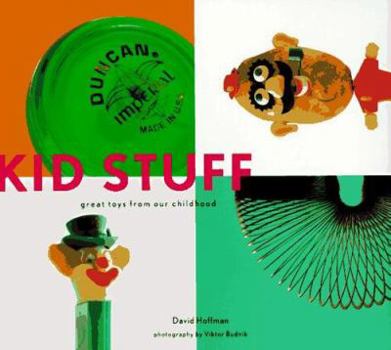Kid Stuff: Great Toys from Our Childhood
Ever wondered if Barbie had a last name? (It's Roberts.) Who invented Lincoln Logs? (John L. Wright, son of Frank Lloyd Wright.) Why a Wiffle Ball has holes? (So you can throw a curve without throwing... This description may be from another edition of this product.
Format:Paperback
Language:English
ISBN:081181162X
ISBN13:9780811811620
Release Date:January 1996
Publisher:Chronicle Books (CA)
Length:107 Pages
Weight:1.25 lbs.
Dimensions:0.4" x 9.0" x 8.1"
Customer Reviews
4 ratings
Terrific Book
Published by Thriftbooks.com User , 18 years ago
One way in which the thinking processes of successful inventors and entrepreneurs differs from the average person is that they often see a potential masker that others fail to see. Many demonstrations of this ability may be found when reading this delightful little book, Kid Stuff. David Hoffman has assembled the histories of the most familiar toys of our childhood. From the Ant Farm to the Whiffle Ball, he details how they were conceived, perfected, and promoted. Consider the Slinky. If Richard James, in 1945, had not been intrigued by how a spring he accidentally dropped "walked" across the floor, the story could have ended right there. But be did see a potential. He perfected it, named it, and packaged it. It then died on the vine at the local retail outlet. Again, the story could have ended right there. However, he realized this was a new item and that it had to be demonstrated. When he demonstrated it at Gimbels, he sold 400 in minutes. In the 50 years since, 250 million have been sold! Three basics in the Slinky story form a common thread that runs through many of these classic toy histories. First, someone sees a potential market; secondly, a dynamite trade name is created; thirdly, clever marketing is utilized. Often the opportunity is in plain sight and, in fact, may have been for some time. Hoffman points out that it is said that the Yo-Yo is actually the second-oldest known toy (after dolls). Yet it remained for Donald Duncan, in 1927, to see the possibilities. Further confirmation that some people do look at the world differently may be had by noting that Duncan also invented the parking meter and introduced the Good Humor "ice cream on a stick." An example of a mental process utilizing analogical thinking may be seen in the history of the Erector Set. Back in 1911, A. C. Gilbert observed girders being assembled for an electric system along the railroad line he frequently traveled. Realizing kids love to assemble things (wood blocks, etc.), he put together a toy kit consisting of girders, gears, pulleys, etc. This power of observing the obvious and seeing the not so obvious is again shown in the history of Mr. Potato Head. George Lerner noticed how children love to play with their food. Who has not? He utilized the observation to create Mr. Potato Head. Incidentally, "Mr. Potato Head was the first toy to ever be advertised on television." The story recites how the toy has been adapted to the times. His pipe was eliminated and the last pipe given to the Surgeon General at the Great American Smokeout. Responding to safety regulation they increased the size of its pasts and made them less sharp. As Hoffman notes, the current Mr. Potato Head may surprise nostalgic parents, but he is still loved by the kids. Another example of how a toy was adapted to the times is Antonio Pasin's original wagon, "Liberty Coaster," of 1923. It was made of wood and it was followed by the classic little red wagon, "Radio Flyer," made of steel. It was ca
Not Just For Kids
Published by Thriftbooks.com User , 19 years ago
From the infamous ant farm to Wooly Willy, this book covers all the hokey and cool toys you probably had if you grew up in the 60s, 70s or even later. The author does a nice job of providing an interesting synopsis of each toy, including its invention, popularity, and success (or lack thereof). There are dozens of obscure facts and stories behind the creation and evolution of these toys, and this book culls them all for us, making it a fun and enjoyable read. The great thing about this book is that the toys featured include those that most of us had as kids (or at least had a friend who had them): Magic 8 Ball, Slinky (my personal favorite), Mr. Potato Head, Tinkertoys....and the list goes on. This book is great for the kid who never grew up.
Every babyboomer should own this book!
Published by Thriftbooks.com User , 23 years ago
These guys have put together a tremendous walk down memory lane. If you want to know the secrets behind your favorite childhood toys (as well as be reminded about how much fun they were)...buy this book. Set it out on a coffee table at your next party, and you are guaranteed an evening of fun reminiscing.This book is more than fun reading...it is childhood joy recaptured.
thanks for the memories
Published by Thriftbooks.com User , 24 years ago
This book brings back wonderful memories. As a child it was wonderful playing and experiencing these wonderful toys. As an adult it is wonderful to find out why and how these classic toys came to be. This book is sure to bring a smile to all who read it.




